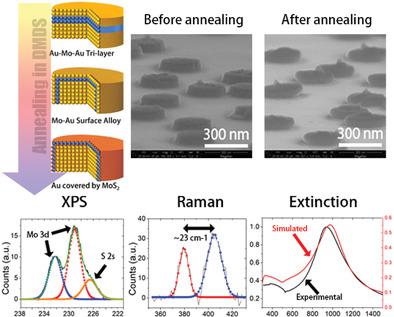当前位置:
X-MOL 学术
›
Adv. Mater. Interfaces
›
论文详情
Our official English website, www.x-mol.net, welcomes your
feedback! (Note: you will need to create a separate account there.)
Direct Integration of Few‐Layer MoS2 at Plasmonic Au Nanostructure by Substrate‐Diffusion Delivered Mo
Advanced Materials Interfaces ( IF 4.3 ) Pub Date : 2020-02-23 , DOI: 10.1002/admi.201902093 Rui Ma 1, 2 , Mark J. Haastrup 2 , Zegao Wang 2, 3 , Yumin Liu 1 , Han Ye 1 , Mingdong Dong 2 , Jeppe V. Lauritsen 2 , Duncan S. Sutherland 2
Advanced Materials Interfaces ( IF 4.3 ) Pub Date : 2020-02-23 , DOI: 10.1002/admi.201902093 Rui Ma 1, 2 , Mark J. Haastrup 2 , Zegao Wang 2, 3 , Yumin Liu 1 , Han Ye 1 , Mingdong Dong 2 , Jeppe V. Lauritsen 2 , Duncan S. Sutherland 2
Affiliation

|
The seamless combination of plasmonic structures with metal oxides and in particular with 2D materials has attracted significant recent interests. Here, a novel approach to grow molybdenum disulfide (MoS2) is presented: an optically active 2D material, directly onto plasmonic nanoscale gold disks via a surface diffusion delivery of Mo from within the nanostructure and a sulfidation process. X‐ray photoelectron spectroscopy and Raman spectroscopy measurements demonstrate the existence and the reaction process of few layered MoS2. Delivery of Mo from within the nanostructure and direct growth of MoS2 has the potential to form better defined metal/MoS2 interfaces compared to exfoliation routes. This facile approach has the potential for application in photodetector or other devices.
中文翻译:

基质扩散传递的钼直接将几层MoS2整合到等离子金纳米结构上
等离子激元结构与金属氧化物,尤其是与2D材料的无缝结合引起了人们的极大兴趣。在这里,提出了一种新的生长二硫化钼(MoS 2)的方法:一种光学活性的2D材料,通过从纳米结构内部进行Mo的表面扩散输送和硫化过程,直接将其沉积在等离子纳米级金盘上。X射线光电子能谱和拉曼光谱测量证明了少数MoS 2层的存在和反应过程。从纳米结构内传递Mo并直接生长MoS 2具有形成更好定义的金属/ MoS 2的潜力界面与剥离路径相比。这种简便的方法具有在光电探测器或其他设备中应用的潜力。
更新日期:2020-02-23
中文翻译:

基质扩散传递的钼直接将几层MoS2整合到等离子金纳米结构上
等离子激元结构与金属氧化物,尤其是与2D材料的无缝结合引起了人们的极大兴趣。在这里,提出了一种新的生长二硫化钼(MoS 2)的方法:一种光学活性的2D材料,通过从纳米结构内部进行Mo的表面扩散输送和硫化过程,直接将其沉积在等离子纳米级金盘上。X射线光电子能谱和拉曼光谱测量证明了少数MoS 2层的存在和反应过程。从纳米结构内传递Mo并直接生长MoS 2具有形成更好定义的金属/ MoS 2的潜力界面与剥离路径相比。这种简便的方法具有在光电探测器或其他设备中应用的潜力。










































 京公网安备 11010802027423号
京公网安备 11010802027423号